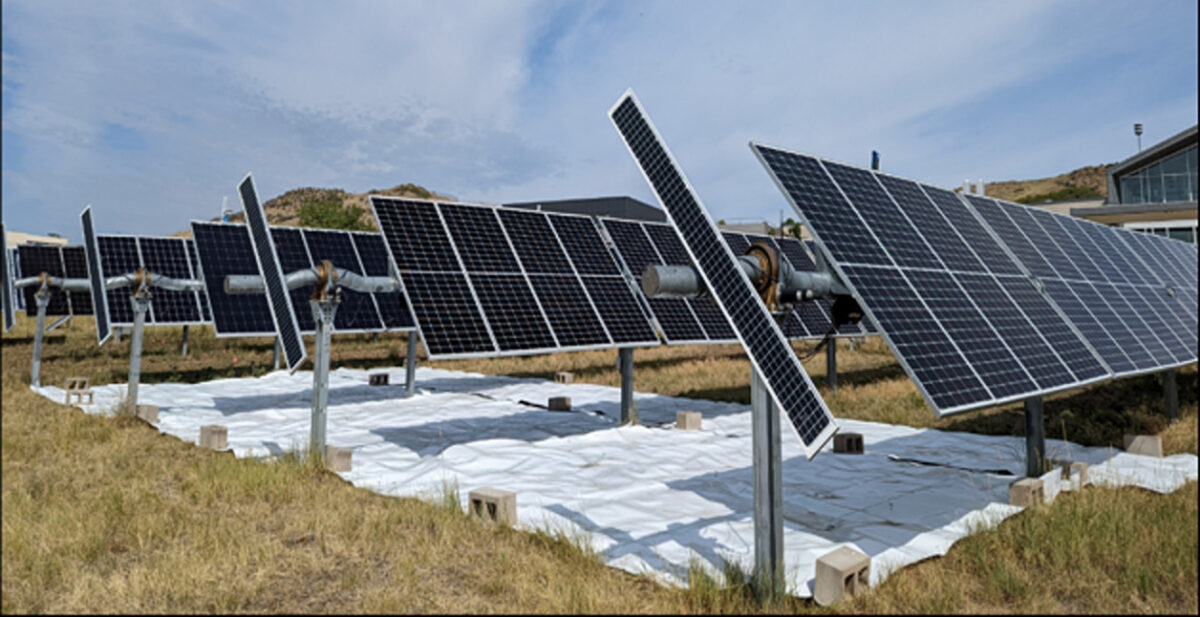Researchers at the University of Ottawa in Canada have investigated the effects of using an artificial ground reflector in large scale bifacial PV plants and have found it can increase a facility's power generation by up to 4.5%.
“Critically, these reflectors should be placed directly under the solar panels, not between rows, to maximize this benefit,” said the research lead author, Mandy Lewis. “These findings are particularly significant in Canada, where snow cover persists for three-to four months of the year in major cities like Ottawa and Toronto, and 65% of the country’s vast landmass experiences snow cover for over half the year.”
The research team conducted its analysis on a 75 kW bifacial system based on horizontal single-axis tracking (HSAT) and located at a testing facility of the US Department of Energy's National Renewable Energy Laboratory (NREL) in Golden, Colorado. “We studied a single row of PERC+ modules with a bifaciality factor of 70%,” it explained, noting that the testing was performed over 4 months. “Module-level power and weather data were measured at 1-min intervals and right-averaged to obtain 15-min power values.”
The scientists utilized an artificial high-albedo, UV-resistant reflector material made of high-density polyethylene (HDPE), provided by Germany-based Solmax Geosynthetics. Its solar-weighted reflectivity reached approximately 70%. They assessed five different reflector configurations: with 100% ground coverage; 50% and 25% ground coverage, both centered on the torque tube; and 50% and 25% ground coverage, both centered in the middle of the open ground between rows.
The performance of the PV system's parts relying on the reflector was compared to that of module rows without the reflector. The modeling presented a root mean square error (RMSE) of 5.4% on an hourly basis and showed an increase in total annual irradiance of 8.6% and an annual energy yield of up to 4.5% when 70% reflective material is added to a single-axis-tracked system. The optimal reflector placement was found to be the one centered directly under the torque tube for all reflector sizes.
Further economic analysis also found the reflector technology can achieve breakeven installed costs of $2.50–4.60 per m2. “Higher breakeven material costs are possible in systems with higher initial LCOE. For example, we found breakeven installed costs of $3.40–6.00/m2 for Seattle, Washington, with 60% reflective material,” the academics stressed.
In addition, they highlighted that the profitability of the reflectors is strictly dependent on the location, with solar radiation levels playing a key role. They also recommended avoiding the deployment of the reflectors in projects with inverter clipping, which occurs when a PV system's DC energy is larger than the maximum input size of the inverter. “Inverter clipping significantly impacts systems incorporating artificial reflectors, reducing the annual energy gain and shifting the ideal placement for the smallest reflectors in some locations,” they warned.
Their experiments are described in the paper “Artificial Ground Reflector Size and Position Effects on Energy Yield and Economics of Single Axis Tracked Bifacial Photovoltaics,” published in Progress in Photovoltaics. “These findings hold particular value for Canada and other countries that are typically cloudy, since power gains of 6.0% were observed in cloudy Seattle compared to 2.6% in arid Tucson,” the researchers emphasized.
Another research group at the University of Ottawa recently developed a new technique to measure the energy yield of bifacial PV systems. The new scaled rear irradiance (SRI) method purportedly improves IEC measurements by accommodating the effects of different ground covers’ spectral albedo in its calculation of the bifacial system’s rear-side irradiance.
This content is protected by copyright and may not be reused. If you want to cooperate with us and would like to reuse some of our content, please contact: editors@pv-magazine.com.




1 comment
By submitting this form you agree to pv magazine using your data for the purposes of publishing your comment.
Your personal data will only be disclosed or otherwise transmitted to third parties for the purposes of spam filtering or if this is necessary for technical maintenance of the website. Any other transfer to third parties will not take place unless this is justified on the basis of applicable data protection regulations or if pv magazine is legally obliged to do so.
You may revoke this consent at any time with effect for the future, in which case your personal data will be deleted immediately. Otherwise, your data will be deleted if pv magazine has processed your request or the purpose of data storage is fulfilled.
Further information on data privacy can be found in our Data Protection Policy.